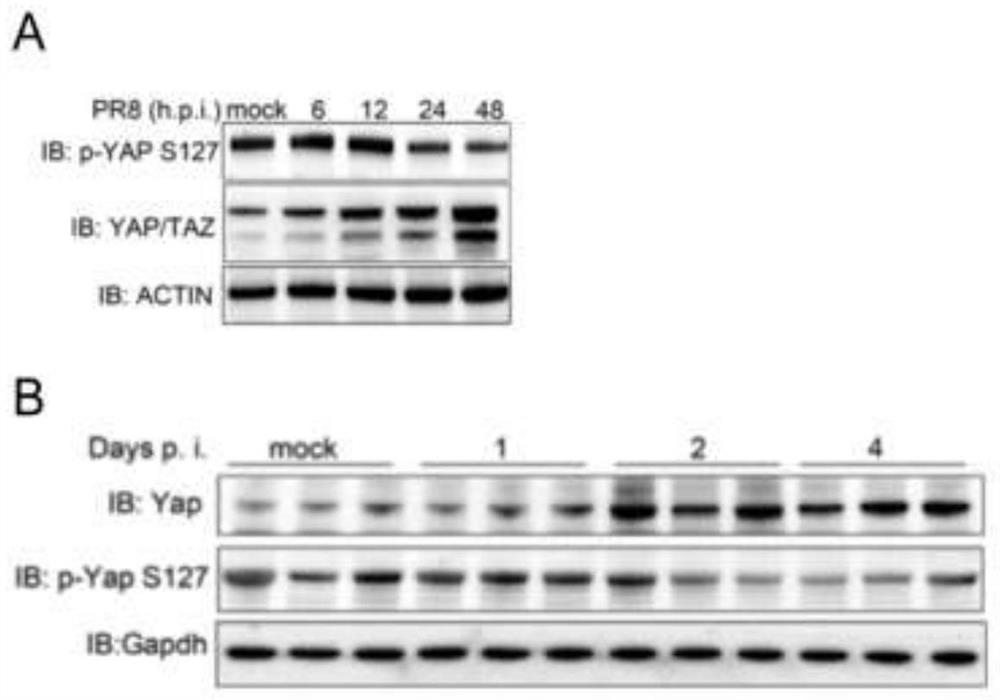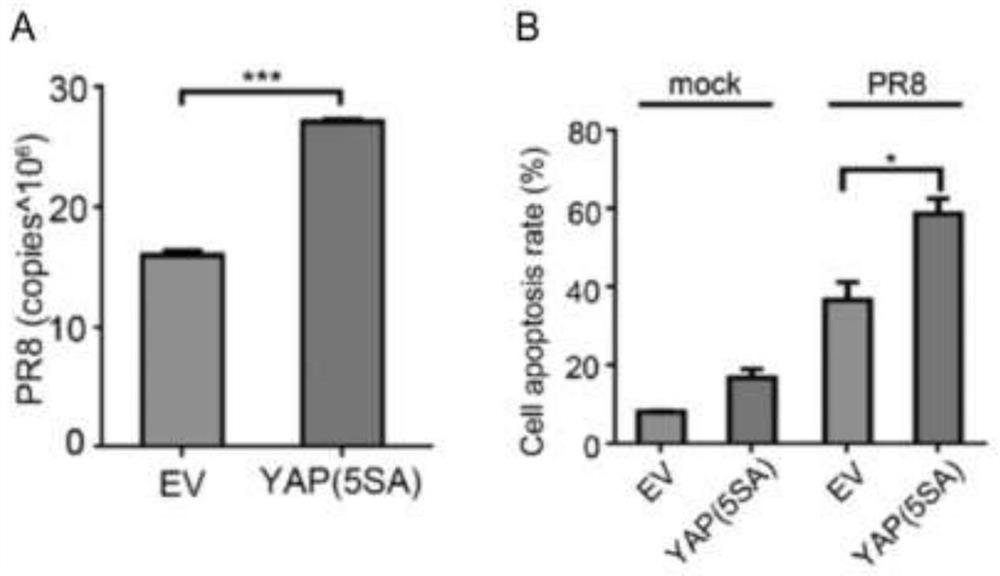Application of YAP/TAZ protein as target molecule in preparation of anti-influenza A virus drugs
A type of influenza A virus and target molecule technology, applied in the direction of antiviral agents, DNA/RNA fragments, viral peptides, etc., can solve problems that have not been related to research, to improve expression, improve host antiviral ability, and inhibit intracellular The effect of the ability to replicate
- Summary
- Abstract
- Description
- Claims
- Application Information
AI Technical Summary
Problems solved by technology
Method used
Image
Examples
Embodiment 1
[0050] Embodiment 1: Analysis of the impact of influenza A virus infection on YAP and TAZ proteins
[0051] In this embodiment, the changes of the expression levels and phosphorylation levels of YAP and TAZ proteins over time after influenza A virus infection were first detected. Spread a strain of human alveolar epithelial cell A549 into a culture dish containing DMEM medium (containing 10% fetal bovine serum and 1% penicillin / streptomycin), and put it in a carbon dioxide incubator (37°C, 5% CO 2 ) cultured to a cell density of approximately 1×10 6 cell / mL, add influenza A virus PR8 (A / PR8 / 34 / H1N1 strain) (MOI=0.01) and continue to co-culture with the cells for 48 hours (the culture conditions are the same as above), and collect at 6, 12, 24, and 48 hours cells, and cells not infected with the virus were used as controls. Collect the cells after centrifugation, add cell lysate and shake to fully lyse the cells, and collect the supernatant after centrifugation again. On the...
Embodiment 2
[0055] Example 2: Analysis of the regulatory effect of influenza A virus non-structural protein NS1 on YAP and TAZ proteins
[0056] In this example, A549 cells were cultured according to the method in Example 1 to a cell density of about 1×10 6 cell / mL, the cells were transfected with a plasmid capable of overexpressing the viral NS1 protein, and the cells not transfected with the plasmid were used as a control, and the cells were collected by centrifugation after continuing to culture for 48 hours. Add cell lysate to the cells and shake to fully lyse the cells, then centrifuge again to collect the supernatant. According to the method in Example 1, the protein in the cell lysed supernatant sample was transferred to a nitrocellulose membrane, and the phosphorylation level and expression level of YAP protein were detected by antibodies. The result is as image 3 As shown, it can be seen that when the NS1 protein is overexpressed in cells, the dephosphorylation level of YAP pr...
Embodiment 3
[0061] Example 3: Inhibition of YAP and / or TAZ can activate TLR3 signaling pathway
[0062] In this embodiment, the changes of TLR3 signaling pathway in A549 cells suppressed YAP and / or TAZ gene were firstly analyzed when infected with influenza A virus.
[0063] Cultivate A549 cells according to the method in Example 1 until the cell density is about 1×10 6 YAP and TAZ gene-specific siRNA were transfected at cell / mL, and the negative control siRNA was used as a control. Influenza A virus PR8 was added to the above two groups of cells according to the multiplicity of infection (MOI=0.01) and infected for 12 h, and cell samples were collected at 0 h, 6 h, and 12 h after infection. The cells were lysed according to the method described in Example 1, and the changes of each protein in the TLR3 signaling pathway were detected by immunoblotting, and the results were as follows Figure 5 shown. It can be seen that compared with the control group, inhibition of YAP and / or TAZ gene ...
PUM
 Login to View More
Login to View More Abstract
Description
Claims
Application Information
 Login to View More
Login to View More - R&D
- Intellectual Property
- Life Sciences
- Materials
- Tech Scout
- Unparalleled Data Quality
- Higher Quality Content
- 60% Fewer Hallucinations
Browse by: Latest US Patents, China's latest patents, Technical Efficacy Thesaurus, Application Domain, Technology Topic, Popular Technical Reports.
© 2025 PatSnap. All rights reserved.Legal|Privacy policy|Modern Slavery Act Transparency Statement|Sitemap|About US| Contact US: help@patsnap.com



